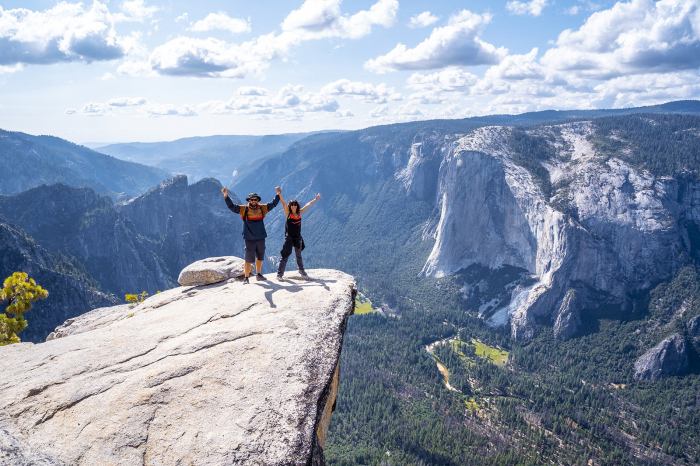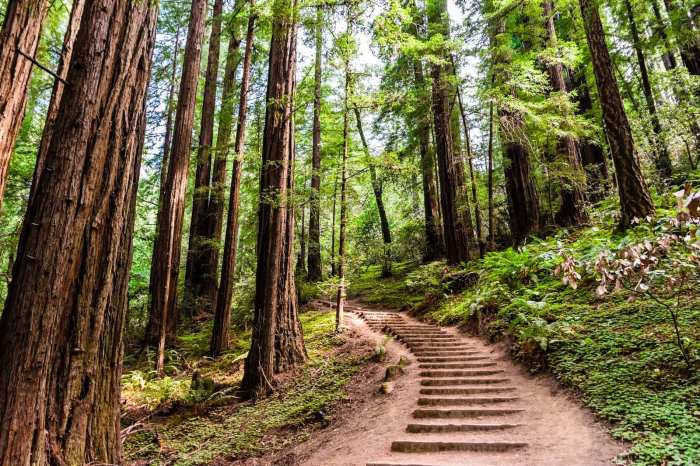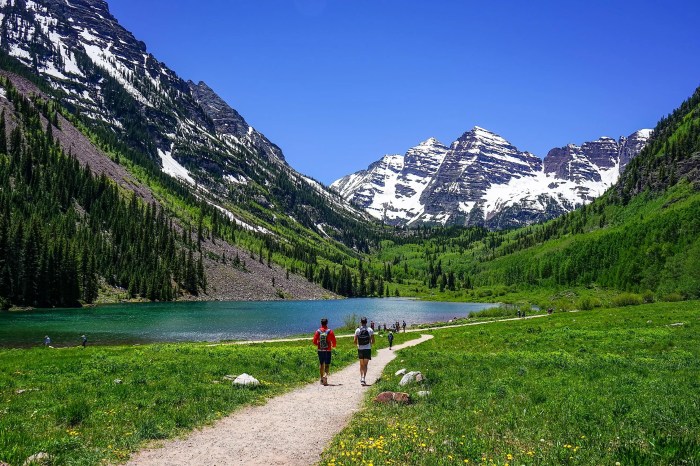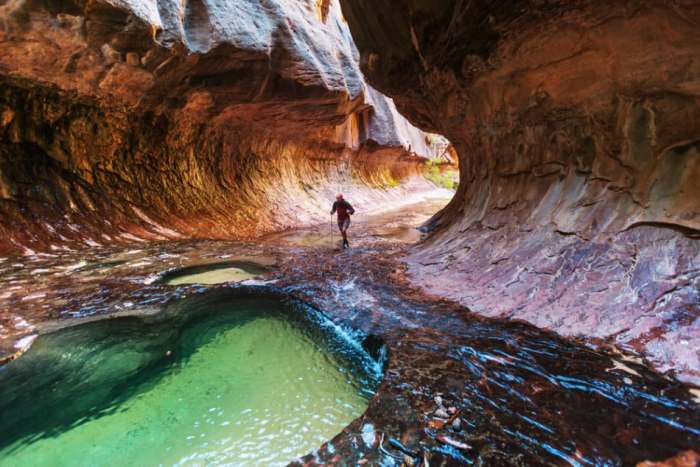Embark on an extraordinary journey through America’s breathtaking wilderness with our guide to the best hiking trails in the US. From towering mountains to pristine forests, each trail offers a unique experience that will leave you in awe.
Whether you’re a seasoned hiker or just starting out, this comprehensive guide will provide you with all the information you need to plan your next adventure.
Trail Characteristics

The United States is a vast and diverse country, and its hiking trails reflect this diversity. From the rugged peaks of the Rocky Mountains to the lush forests of the Pacific Northwest, there is a trail for every hiker.
The terrain and elevation profiles of hiking trails in the US vary greatly. Some trails are relatively flat and easy to hike, while others climb steeply through challenging terrain. The elevation gain on a trail can also vary significantly, from a few hundred feet to several thousand feet.
Plan your adventure with a travel itinerary template to explore the best hiking trails in the US. These templates provide a structured framework to organize your trip, ensuring you cover all the must-visit trails and plan for transportation, accommodation, and meals.
With a well-crafted itinerary, you can maximize your time and enjoy the breathtaking landscapes that the US wilderness has to offer.
The length of hiking trails in the US also varies greatly. Some trails are just a few miles long, while others stretch for hundreds of miles. The difficulty of a trail is typically determined by its length, elevation gain, and terrain.
Trail Comparison
The following table compares the length, difficulty, and scenic highlights of some of the most popular hiking trails in the US:
| Trail | Length (miles) | Difficulty | Scenic Highlights |
|---|---|---|---|
| Appalachian Trail | 2,190 | Difficult | Stunning mountain views, lush forests, and cascading waterfalls |
| Pacific Crest Trail | 2,650 | Difficult | Diverse landscapes, including deserts, mountains, and forests |
| Continental Divide Trail | 3,100 | Difficult | Follows the Continental Divide through the Rocky Mountains |
| John Muir Trail | 211 | Moderate | Stunning views of the Sierra Nevada mountains |
| Zion Narrows | 16 | Easy | Hike through a narrow slot canyon with towering sandstone walls |
Regional Highlights

The United States boasts a diverse range of hiking trails, each offering unique experiences influenced by the region’s distinct landscapes and ecosystems.
From the towering peaks of the Rocky Mountains to the lush forests of the Pacific Northwest, each region presents its own allure for hikers.
The Rockies
The Rocky Mountains, stretching from Canada to New Mexico, are renowned for their dramatic peaks, alpine lakes, and pristine wilderness. Trails in this region often climb to high altitudes, offering breathtaking views and challenging ascents.
- Mount Whitney Trail (California): The highest peak in the contiguous United States, Mount Whitney offers a challenging but rewarding hike with panoramic views from the summit.
- Rocky Mountain National Park (Colorado): This park offers a wide range of trails, from easy strolls to strenuous climbs, showcasing the park’s diverse ecosystems and wildlife.
The Appalachians
The Appalachian Mountains, spanning from Newfoundland to Alabama, are known for their rolling hills, ancient forests, and rich history. Hiking trails in this region often follow historic routes and offer opportunities for cultural immersion.
- Appalachian Trail (Maine to Georgia): The iconic Appalachian Trail traverses 14 states, offering a transformative experience through diverse landscapes and challenges.
- Great Smoky Mountains National Park (Tennessee and North Carolina): This park boasts a vast network of trails, leading to waterfalls, scenic overlooks, and the highest peaks in the eastern United States.
The Pacific Northwest
The Pacific Northwest, encompassing Washington, Oregon, and northern California, is characterized by lush rainforests, towering mountains, and rugged coastlines. Hiking trails in this region often lead to stunning waterfalls, pristine lakes, and panoramic ocean views.
From the towering peaks of the US’s best hiking trails, we turn our gaze to the sun-kissed shores of the Caribbean. Discover the pristine sands and turquoise waters of the best beaches in the Caribbean , where relaxation and adventure await.
Then, return to the rugged trails of the US, where every step brings you closer to breathtaking vistas and unforgettable experiences.
- Mount Rainier National Park (Washington): This park is home to Mount Rainier, an iconic volcano, and offers trails ranging from easy walks to challenging climbs.
- Olympic National Park (Washington): This park boasts a diverse landscape, including rainforests, mountains, beaches, and glaciers, offering trails for all levels of hikers.
Seasonal Considerations
![]()
Seasonal changes can significantly impact hiking conditions and trail accessibility. Factors such as weather, wildlife activity, and crowds vary throughout the year, influencing the overall hiking experience.
To help you plan your hiking adventures, here’s a table outlining the best time of year to hike in different regions, considering these seasonal factors:
Best Hiking Seasons by Region
| Region | Best Time to Hike | Factors Considered |
|---|---|---|
| Northeast | Spring (April-May) and Fall (September-October) | Mild temperatures, fewer crowds, and vibrant foliage |
| Southeast | Spring (March-April) and Fall (October-November) | Comfortable temperatures, fewer insects, and reduced humidity |
| Midwest | Spring (April-May) and Fall (September-October) | Pleasant temperatures, minimal bugs, and fewer crowds |
| Southwest | Spring (March-April) and Fall (October-November) | Mild temperatures, lower elevations, and fewer crowds |
| Northwest | Summer (July-August) and Fall (September-October) | Clear skies, minimal precipitation, and stunning fall colors |
| California | Spring (March-May) and Fall (September-October) | Moderate temperatures, fewer crowds, and diverse landscapes |
Planning and Preparation

Embarking on a hiking adventure requires meticulous preparation to ensure a safe and enjoyable experience. From selecting the right gear to training adequately and mastering navigation techniques, planning and preparation are paramount.
To ensure a successful hike, it’s crucial to pack essential items and take necessary precautions. A well-prepared hiker is a confident hiker, ready to embrace the challenges and rewards of the trail.
Gear Selection
Choosing the right gear is vital for comfort, safety, and efficiency on the trail. Consider the following:
- Footwear: Hiking boots or shoes provide support, stability, and protection for your feet.
- Backpack: A comfortable and appropriately sized backpack is essential for carrying gear and supplies.
- Clothing: Pack moisture-wicking, breathable fabrics that can be layered for warmth and protection.
- Hydration: Bring plenty of water or a water purification system to stay hydrated.
- First-aid kit: A basic first-aid kit can treat minor injuries and emergencies.
Training and Fitness
Training prepares your body for the physical demands of hiking. Start gradually and increase distance and elevation gain over time. Consider these tips:
- Build endurance: Regular aerobic activities like running or cycling improve cardiovascular fitness.
- Strengthen leg muscles: Exercises like squats and lunges strengthen the muscles used for hiking.
- Hike with weight: Practice hiking with a weighted backpack to simulate the load you’ll carry.
Navigation Techniques
Knowing how to navigate the trail is crucial for safety and efficiency. Familiarize yourself with these techniques:
- Map and compass: Learn to use a topographic map and compass to determine your location and direction.
- GPS device: A GPS device can provide real-time location tracking and navigation assistance.
- Trail signs: Pay attention to trail signs and markers to stay on course.
Safety and Etiquette

Hiking can be an incredibly rewarding experience, but it’s essential to prioritize safety and respect for both the environment and fellow hikers. By adhering to proper etiquette, you can ensure a safe and enjoyable adventure for yourself and others.
Wildlife encounters are an inherent part of hiking, and it’s crucial to approach them with caution. If you encounter an animal, remain calm and avoid sudden movements. Give the animal ample space and observe its behavior from a distance. Never attempt to approach, feed, or provoke wildlife.
Weather Emergencies
Weather conditions can change rapidly while hiking, so it’s essential to be prepared for emergencies. Check the forecast before you embark on your hike and pack appropriate clothing and gear. If you encounter severe weather, seek shelter immediately and avoid open areas or high ground. Monitor the weather conditions and be prepared to adjust your route or turn back if necessary.
Trail Etiquette, Best hiking trails in the US
Respecting trail etiquette is essential for maintaining a harmonious and enjoyable hiking experience. Always yield to hikers coming from the opposite direction, and be mindful of your noise levels. Avoid littering and dispose of waste properly. Stay on designated trails to minimize erosion and protect fragile ecosystems.
| Practice | Description |
|---|---|
| Stay on designated trails | Protects vegetation and prevents erosion |
| Pack it in, pack it out | Keeps the environment clean and prevents wildlife conflicts |
| Respect wildlife | Observing from a distance protects both animals and hikers |
| Be mindful of noise levels | Respects other hikers and wildlife |
| Yield to uphill hikers | Uphill hikers have the right of way |
Trail Accessibility

Many hiking trails in the US are accessible to hikers with disabilities or mobility limitations. These trails may feature paved or graded surfaces, accessible campsites, and adaptive equipment rentals.
From the breathtaking vistas of the Appalachian Trail to the rugged beauty of the Pacific Crest Trail, the United States boasts some of the world’s most renowned hiking trails. However, for those seeking a cultural immersion beyond the wilderness, a detour to one of the best cultural festivals worldwide is a must.
From the vibrant Holi festival in India to the awe-inspiring Burning Man in Nevada, these festivals offer a glimpse into diverse traditions and ignite a passion for global exploration. Afterward, returning to the serene solitude of America’s hiking trails will provide a renewed appreciation for the natural wonders that await.
Before embarking on an accessible hike, it’s crucial to research the trail’s accessibility features and plan accordingly. Check trail websites or contact park rangers for detailed information on trail conditions, accessible amenities, and available adaptive equipment.
Adaptive Equipment
- Wheelchairs: All-terrain wheelchairs designed for rugged outdoor use are available for rent or purchase.
- Handcycles: Three-wheeled cycles with hand-operated cranks provide mobility for individuals with lower body limitations.
- Adaptive strollers: These specialized strollers are designed to accommodate children with disabilities, providing a comfortable and safe ride on trails.
- Trekking poles: Trekking poles can provide additional stability and support for hikers with balance or mobility issues.
Accessible Campsites
- Designated accessible campsites: Many campgrounds offer campsites specifically designed for individuals with disabilities, featuring accessible restrooms, showers, and picnic tables.
- RV hookups: Some campgrounds offer RV hookups for accessible RVs, providing a comfortable and convenient base for hikers.
- Accessible cabins: Some campgrounds offer accessible cabins with features such as roll-in showers, wider doorways, and accessible kitchens.
Other Resources
- Trail maps and guides: Accessible trail maps and guides are available online or at park visitor centers, providing detailed information on trail accessibility and features.
- Disability access passes: Individuals with disabilities may qualify for disability access passes, which offer reduced fees or free admission to national parks and other public lands.
- Support organizations: Organizations such as the National Park Service’s Every Kid Outdoors program and the American Hiking Society provide resources and support for hikers with disabilities.
Trail Management

Trail management involves the upkeep, conservation, and improvement of hiking trails. This responsibility falls on organizations and agencies, such as the National Park Service, US Forest Service, and various non-profit trail organizations. These entities work to maintain trail infrastructure, address erosion issues, and protect the natural environment along the trails.
Hikers can contribute to trail maintenance and conservation efforts through various means. By staying on designated trails, they help prevent erosion and damage to sensitive vegetation. Packing out all trash and respecting wildlife are essential practices that minimize the impact on the environment. Hikers can also volunteer with trail organizations to assist with trail maintenance, cleanup, and restoration projects.
Trail Closures and Permits
Trail closures may occur due to weather conditions, maintenance work, or wildlife concerns. Hikers should check with the relevant managing agency for up-to-date information on trail closures and any required permits.
Leave No Trace Principles
Hikers should adhere to Leave No Trace principles to minimize their impact on the environment. These principles include packing out all trash, staying on designated trails, respecting wildlife, and minimizing campfire impacts.
Final Review: Best Hiking Trails In The US

As you traverse these iconic trails, you’ll not only witness the stunning beauty of our nation’s landscapes but also create memories that will last a lifetime. So lace up your boots, gather your companions, and get ready to explore the best hiking trails in the US.
General Inquiries
What are some of the most challenging hiking trails in the US?
Mount Whitney Trail, Half Dome Trail, Angels Landing Trail
What is the best time of year to hike in the US?
Spring and fall offer the most comfortable temperatures for hiking in most regions.
What are some tips for hiking safely?
Always hike with a companion, inform someone of your plans, and be prepared for changing weather conditions.